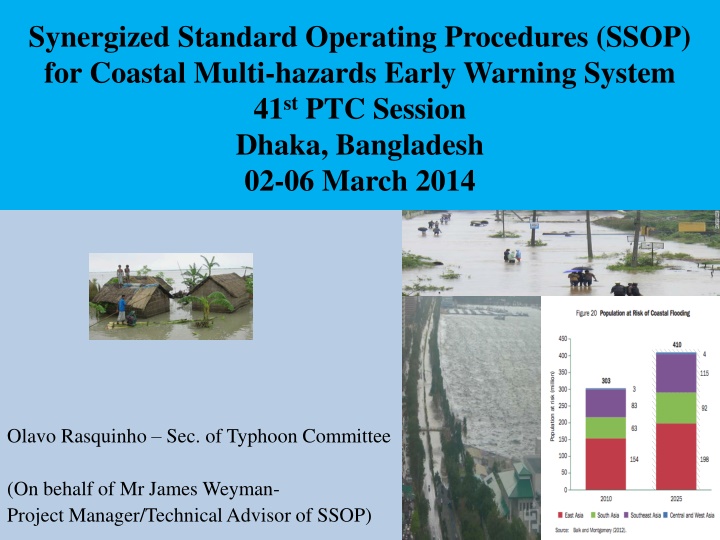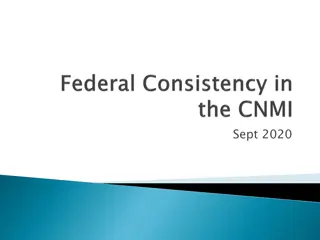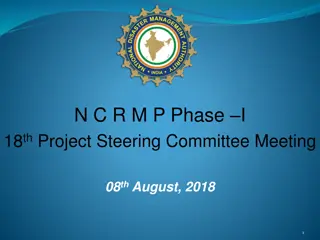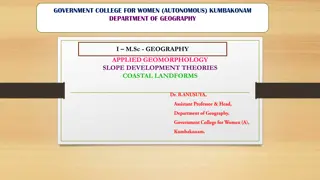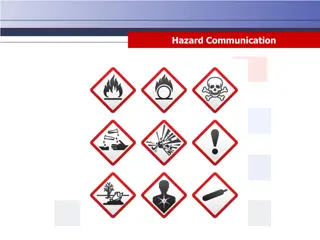Enhancing Coastal Multi-Hazard Early Warning Systems through Synergized Standard Operating Procedures
The SSOP project aims to strengthen community resilience to coastal multi-hazards by developing integrated standard operating procedures for early warning systems. The initiative targets various countries in the Asia-Pacific region to improve policy and institutional frameworks for disaster preparedness and response. By synergizing existing SOPs and enhancing cooperation between stakeholders, the project seeks to build capacity and improve the effectiveness of warning systems. Through trainings, workshops, and manual development, the project envisions a more robust and collaborative approach to disaster risk reduction and management.
Uploaded on Nov 19, 2024 | 7 Views
Download Presentation

Please find below an Image/Link to download the presentation.
The content on the website is provided AS IS for your information and personal use only. It may not be sold, licensed, or shared on other websites without obtaining consent from the author.If you encounter any issues during the download, it is possible that the publisher has removed the file from their server.
You are allowed to download the files provided on this website for personal or commercial use, subject to the condition that they are used lawfully. All files are the property of their respective owners.
The content on the website is provided AS IS for your information and personal use only. It may not be sold, licensed, or shared on other websites without obtaining consent from the author.
E N D
Presentation Transcript
Synergized Standard Operating Procedures (SSOP) for Coastal Multi-hazards Early Warning System 41stPTC Session Dhaka, Bangladesh 02-06 March 2014 Olavo Rasquinho Sec. of Typhoon Committee (On behalf of Mr James Weyman- Project Manager/Technical Advisor of SSOP)
SSOP Project Goal: To promote community resilience to coastal multi-hazards and to improve the policy and institutional arrangements at national, district, and community levels through integrated, effective standard operating procedures for multi-hazards early warning system Focused mainly on the National Meteorological and Hydrological Services to meet the needs of diverse users Funded by: ESCAP Trust Fund for Tsunami, Disaster and Climate Preparedness in Indian Ocean and Southeast Asian Countries Time Frame: 29 months (1 August 2012 31 December 2014 (extension requested)
Beneficiary Countries PTC region (7): Bangladesh (Pilot); India; Maldives; Myanmar; Pakistan (Pilot); Sri Lanka; Thailand TC region (7): Cambodia; China; Lao PDR; Malaysia; Philippines (Pilot); Thailand and Viet Nam
Outcomes Expected Outcome 1: Integrated, effective standard operating procedures for coastal multi-hazard EWS for TC and PTC Members Support Activity 1: Review and synergize existing SOPs for coastal multi-hazards EWS and develop a Manual of Synergized SOPs for Coastal Multi-Hazards EWS 1.1 Conduct workshop to collect and analyse performance status of coastal multi-hazard EWS and associated SOPs. (8-9 May 13) 1.2 Conduct pilot missions and workshops to identify strengths, gaps, and needs of SOPs for EWS. (Completed) 1.3 Synergize existing SOPs and develop additional ones as needed to meet identified gaps and needs and compile a Manual of Synergized SOPs for Coastal Multi-Hazards EWS (In process)
Outcomes Expected Outcome 2: Improved performance and effectiveness of SOPs for coastal multi-hazard EWS through integration, synergization, cooperation, and training. Support Activity 2: Enhance the performance and effectiveness of SOPs for coastal multi-hazard EWS through capacity building 2.1 Conduct training of users and issuers in the interpretation and preparation of EWS products for decision-making, media, and communications both in a large group and with individual missions 2.2 Conduct working meeting on building a cooperation mechanism between TC and PTC for coastal multi-hazard EWS information sharing and technical transferring
SSOP Project Output Main Output 1: Manual of Synergized Standard Operating Procedures (SSOP) for Coastal Multi-Hazards Early Warning System, mainly focusing on hydro-meteorological service including SOPs related to warning providers, disaster managers, media, and fishermen. Main Output 2: Regular communication and cooperation mechanism between TC and PTC on coastal multi-hazard early warning, particularly southern countries in the region.
Other Projects Under ESCAP Tsunami Trust Fund Asian Disaster Preparedness Center (ADPC) in association with Global Alliance on Accessible Technologies for Environment (GAATES) Technical Assistance for enhancing the capacity of end-to-end multi-hazard EWS for coastal Hazards in Myanmar, Sri Lanka and Philippines Asia-Pacific Broadcasting Union (ABU) Disaster Risk Reduction Broadcast Media Initiative Regional Integrated Multi-Hazard Early Warning System (RIMES) in cooperation with World Meteorological Organization Reducing risks of tsunami, storm surges, large waves and other natural hazards in low elevation coastal zones
Partners TC and PTC Country Focal Points (NMHS and NDMO) ESCAP Economic and Social Commission of Asia and Pacific TC Typhoon Committee PTC Panel on Tropical Cyclones ADPC Asian Disaster Preparedness Center ABU Asia-Pacific Broadcasting Union GAATES Global Alliance on Accessible Technologies for Environments ADRC Asian Disaster Reduction Center IOC Intergovernmental Oceanographic Commission of UNESCO WMO World Meteorological Organization RIMES Regional Integrated Multi-Hazard Early Warning System
Structure of SSOP Project Steering Committee Composition Chairperson of TC AWG, TC Secretary, and PTC Secretary Duties Select Consultant (s) and Project Manager Provide guidance to Task Force, Project Manager and Consultant(s) Monitor progress of the SSOP project implementation Program Manager/Technical Advisor Duties Implement SSOP in accordance with planned schedule Coordinate related programmes or activities Prepare progress reports Coordinate draft Manual of SSOP for Coastal Multi-Hazards EWS
Structure of SSOP Project (Cont.) Task Force Structure and Organization Chairpersons/representatives of WGM, WGH, WGDRR, TRCG of TC, Chairpersons/representatives of WGM, WGH, WGDRR of PTC/ Heads of RSMC Representatives from TC and PTC Secretariats Consultants from potential cooperation organizations Focal points from 13 beneficiary countries among Members of TC and PTC (also from non beneficiary countries Japan, Rep of Korea and Hong Kong, China)
Conclusions - May 8-9 2013 Initial Workshop Manual of Synergized Standard Operating Procedures Wide variety of cultures, governments, past experiences, relationships, risks, and people - SSOPs must be flexible best practices, operational guidelines and recommendations Focused on meteorological and hydrological services, disaster management offices, and national tsunami warning centers. Other agencies must be involved in detailed, integrated ways to make end to end, cross-cutting EWS work. Various user sectors needs within government, businesses, and communities should be addressed. Need for policy part of SOP development. With different agencies and government levels, policy framework required for success.
Conclusions - May 8-9 2013 Initial Workshop (Cont.) Training and Human Capacity Building Technical required, but also other types needed. Train warning preparer to communicate better with media and media to better understand risks and potential impacts. Awareness of risks, potential, similarities and differences among coastal hazards at various levels needed At community level, training on meaning of warnings, risk, potential, and actions needed. Methods needed to increase awareness especially for areas not significantly impacted for 10 -30 years.
Three In-Country Pilot Workshops Team Members Jim Weyman, Project Manager/Technical Advisor (Philippines and Bangladesh, Skype into Pakistan) Olavo Rasquinho, Meteorological Expert, TCS Atiq KainanAhmed, Disaster Response Expert, ADPC Walter Welz, Media Expert, ABU (Philippines and Bangladesh) Ahmed Said Al Barwani, Hydrology Expert, PTC (Oman) NadeemAhmed, Media Expert, ABU (visited Pakistan)
Three In-Country Pilot Workshops (Cont.) In Country Pilot Workshops were held: October 3-4, 2013 Manila, Philippines October 6-7, 2013 Dhaka, Bangladesh October 10-11, 2013 Islamabad, Pakistan Draft copies of detailed reports of pilot workshops, a summary report, and report of the May 8-9, 2013 kickoff meeting (and other related documents) at: http://www.typhooncommittee.org/SSOP/indexSSOP.html
Purpose of Pilot Workshops Sub-Activity 1.2:Conduct pilot missions and workshops focused on institutional capacity building from the national level to the local level and identification of pilot countries strengths, needs, and gaps in the area of EWS SOPs. Workshop Purpose Review existing SOPs for coastal multi-hazards EWS for hydro-meteorological, disaster management, media, elected official, and others from national to local levels Identified strengths, gaps and needs in both agency internal SOPs and also integrated SOPs among agencies. Develop an action plan
Conclusion Pilot Workshops - EWS Recurring Themes of Required Items High level government commitment and support Legal and legislature framework. Collaboration/coordination national, regional, and local. Media involvement as a partner. Multi-hazard approach Fully implemented elements of a people centered EWS Technical and financial assistance to prepare required SOPs
Conclusion Pilot Workshops - SOPs Strengths Favorable framework for creation/maintaining SOPs. Excellent examples of existing SOPs Systems in detection, monitoring, forecasting, and warning services System/situation in dissemination &communications Systems in response and preparedness capacity Supporting MOUs in place
Conclusion Pilot Workshops - SOPs Gaps and Needs SOPs for Specific Areas Roles and responsibilities defined in national policies SOPs for both technical and non-technical activities Hydro-meteorological service SOPs on all aspects of forecast and warning process SOP to cover back-up plans for catastrophic events such as power failure, fire, earthquake damage, etc. SOP to prepare after action reports to release to media & public Local government SOPs on evacuation, sheltering, and resettlement
Conclusion Pilot Workshops - SOPs Gaps and Needs Integrated, cross-cutting SOPs Needs Multiagency SOP on dissemination process Multiagency SOP on mechanism for sharing data/data analysis Local communities SOPs to prevent conflicting activities Coordination procedures on dissemination of warnings at all levels and agencies to prevent conflicting information Coordinated procedures for implementing new/updated SOPs Involvement of non-government private, professional, civil society, community organizations and families in SOPs Reference manual for media to understand/communicate information
Conclusion Pilot Workshops - SOPs SOP testing and maintaining needs Annual or scheduled reviews of all SOPs Updated based on past experience and changes Conduct post disaster assessment between DRR and media MOU related needs National plan/MOU clearly defining roles and responsibilities DRR and media MOU to define single, official source of data Hydro-meteorological service & media MOU on dissemination Hydro-meteorological service and DRR MOU MOU on data formats, warnings, and monitoring systems
Conclusion Pilot Workshops - Manual Manual/Handbook should contain: Minimum baseline standard & guidelines on format and content Checklist for SOPs for different types/levels of threat Guidelines for multi-hazards SOPs Need for regular updating after a disaster Need to conduct regular exercises/drills to validate SOPs SOP examples from other countries List of relevant available websites, case studies, documents, etc. Examples of social media use for information dissemination Need to incorporate designation of spokesperson for event
Compilation of EWS and SOP Guidance and Checklist Prepared prior to In-Country Pilot Workshops to demonstrate information available and necessary for the Manual Compilation - A Guide to Writing Effective SOPs Compilation - Checklist for Effective SOPs for EWS Compilation - Information on Early Warning System Overview Compilation - Early Warning System Checklist Items Compilation - General Basic Information on EWS for NHMS, Warnings, Communications, and Relationships Based upon many different documents including ones from the Shanghai Meteorological Service and WMO
Future Plans and Activities Activity 1.3 Prior activities been focused on involvement of pilot countries; focus shifts to broader involvement Three prong approach: Missions/consultants to three pilot countries to obtain specific SOPs in use and to refine needs and gaps Missions/consultants to 6 other beneficiary countries to get specific SOP examples and inputs on needed ones. Focal points involvement. Program Manager, SSOP Task Force, TCS, and PTC begin compiling manual on SSOPs based on information collected in pilot workshops and two items above
Future Plans and Activities Activity 2.1 Training session for 50 decision-makers, disaster managers, media professionals, and warning issuers from 13 target countries - possibly the second week of June 2014. Experts in meteorology, hydrology, DRR, media, social science, plus Program Manager, TCS and PTC representatives will assist Train the Trainer Concept Missions to approximately 6 selected targeted countries to provide technical and financial assistance to assist initial develop, update, coordinate, and implement improved SOPs (need identified in pilot workshops)
Future Plans and Activities Activity 2.2 Conduct working meeting for approximately 20 participants from target countries on building cooperation mechanism between TC and PTC for coastal multi-hazard EWS and SOPs information sharing and technical transferring. (Most likely in September October 2014) TC and PTC members focal points for a joint cooperative mechanism involved Analyze current actions of the TC and PTC and how these can be used along with additional developed ones to create a sustainable cooperative mechanism between TC and PTC
Future Plans and Activities Monitoring, Evaluation, and Audit Scheduled for October December 2014 Independent end of term evaluation commissioned by Typhoon Committee Secretariat in consultation with partners and ESCAP Purpose: To facilitate learning TCS will commission independent audit of the project funds at end of project and will submit to ESCAP
Resolutions of TC46 on SSOP Approve the submission of no cost extension request to ESCAP for the SSOP project until 31 December 2014, instead 31 July 2014; Encourage Members, in particular the SSOP beneficiary countries to collaborate with the SSOP project. Encourage Members continuing cooperation on SSOP in 2014 assisting the manual drafting and training workshop; Approve the organization of a SOP workshop in the WMO RTC Nanjing.
